Since I like my scenery to be incredibly durable and easy to store, I had to come up with my own way to make trench scenery that didn't rely on styrofoam and cardboard. As it turns out, even sturdy trenches are easier than you might think, as trenches are pretty messy by their nature, and thus forgiving of quick work. The techniques described below can also be used to make rivers, sumps, mines, catacombs, junk piles, even ship wrecks!
Back to Trench Scenery
Back to the How-To Pages
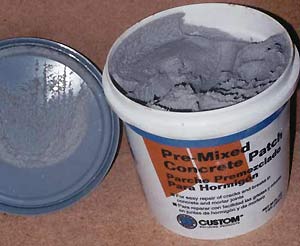 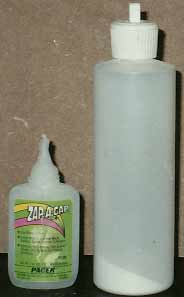 |
| CONCRETE PATCH works like filler, but it is more grainy and thick, and has actual concrete in it. This stuff is incredibly strong!!! You can even use it to glue stuff together (messy but strong). It's not chalky like most fillers. It also sticks to almost anything, if you dab at it long enough. I've even rubbed it over smooth porcelain to get some texture on it. (thanks to Cory for this find). |
| CA GLUE (aka superglue, crazy glue). My favorite brand is Zap-A-Gap, available in hobby shops. And whenever using CA glue, be sure to have a squeeze bottle of BAKING SODA handy (available at the supermarket). once you have put the CA glue on, squeeze the bottle to blow baking soda dust onto it- this cures the glue quickly, and helps fill gaps! Do this in layers to build up a massively strong bond across any gaps between pieces you want to glue together... |
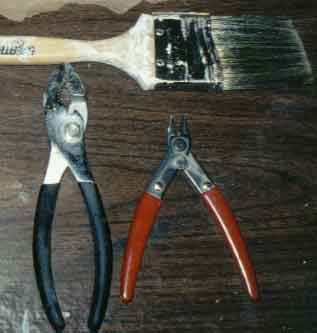 |
| PLIERS Get yourself a big, chunky pair of pliers with nice wide teeth. These are useful for breaking up your fiberboard into manageable, natural looking chunks. They are also good for bending metal (like that hard-as-steel perforated scrap metal you found). |
| NIPPY CUTTERS (also known as diagonal cutters, clippers, hobby cutters). No great model builder is without a pair of these- great for trimming plastic, and also good for adding battle damage to plastic and wood pieces! I got mine cheap at Radio Shack (electronics supply shop known for cheap components). |
 |
| WOODEN STICKS All manner of sticks can be used- popsicle sticks and coffee stir sticks (for floor boarding and fence posts), toothpicks (for spikes or real fine floorboarding). Popsicle sticks are also good for applying filler- you can get a big box of 'em cheap at most crafts shops. |
| CORRUGATED, PERFORATED, OR REINFORCED SHEETS Metal or plastic are fine (though plastic is easier to work with). I found some perforated metal (metal with holes in it) in a metal recycling center down the road (lucky me). I also found that some miniatures bases look good for reinforced metal- and the old Milton Bradley Battlemasters infantry stands look awesome on the bottom! |
| GARDEN ROCKS You can use any kind of rock, really, but those artificially made, red volcanic looking garden rocks work great! They are light, strong, and have a great texture that paints up well. You can get these in some Hardware/ DIY shops, and most garden / landscaping shops, or just steal some from your neighbor's front yard when they aren't looking. |
| FIBERBOARD (a.k.a. hardboard, press board, masonite, HDF board). Most hardware / DIY stores sell this stuff cheap. Get the 1/8" thickness, as it is plenty sturdy and easier to work with than the heavier stuff. You can pick up a 4' x 8' sheet at Orchard Supply Hardware for about 3 bucks. Pegboard can also be used, though you have to hide the holes so it's a bit more work and not quite as strong. |
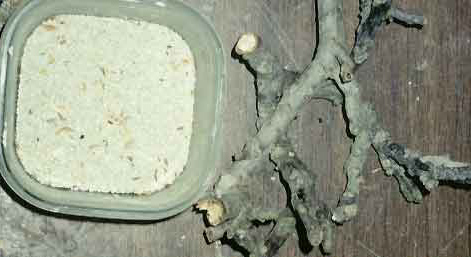 |
| MORE WOOD I found some great looking tree branches in the park, perfect for dead tree stumps. |
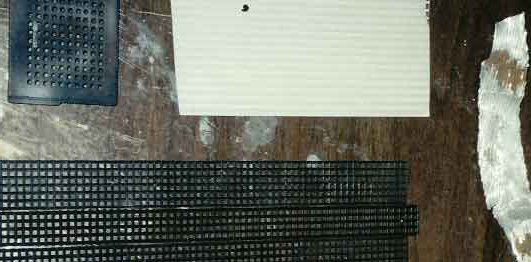 |
| CROSS STITCH GRID (aka "granny grating", cross stitch cloth). This looks like plastic grid, slightly waxy and flexible. It comes in a variety of colors, so try to find black or brown if you can. Be sure to sand both sides so it glues better and holds paint. |
| CORRUGATED PLASTIC, METAL I found some plastic window blinds (the vertical kind) that have ridged detail on them, perfect for representing corrugated metal! You can use corrugated cardboard (packing material, craft shops) or scored plastic (hobby shops) too. I got some soft, corrugated aluminum from an auto junk yard (part of a hose or something). |
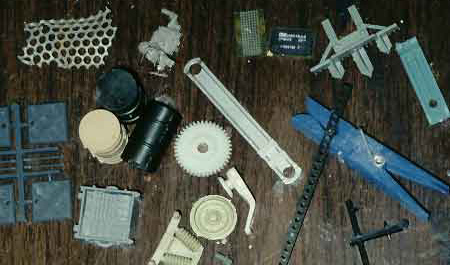 |
| BATTLEFIELD ACCESSORIES and DEBRIS The Drums, crates, and tank traps sold by GW on sprues is perfect. You can also use wooden drums, wooden crates, and all manner of battlefield debris (empty .22 shells for artillery shells, parts from tank model kits, bits of metal or plastic from other projects, etc.) Also, be sure to scour toy and discount stores for army toys that might have cool accessories (I found some great barbed wire pieces in a very cheap army play set). Even plastic sprue can be used for barbed wire fence posts, wreckage, I-beams, tank traps, etc. Even the old Epic bases with the round holes in them look great as reinforcing plates. |
First, cut or snap off a chunk of fiberboard (I like to start with pieces about 2' square). Take your pliers and grab an edge or corner, then bend upward to snap off some of the fiberboard at the edge. Continue along the edges, taking bigger or smaller "bites" out of the fiberboard to make a rough, irregular shape. This should produce a ragged edge that looks WAY more natural than a round cut or (heaven forbid) a perfect square!
Next, grab a pen (permanent markers or sharpies work great) and draw out rough lines for how you want to run your trenches. Remember to make your trenches AT LEAST 1" wide- when you start putting in wall details, the trench width can shrink, so I usually leave at least an inch and a half of space when drawing them out. Typically trenches are straight lines (easier to build) that zig zag back and forth in crazy angles, so be creative when drawing your lines! Curves look good too, but are much harder to make.
Now get your Concrete Patch handy and grab some of those rocks. Spreat some concrete patch onto the bottom of a rock, then press it down onto the fiberboard to glue it in place. If the rocks are really irregular, just use more concrete patch to make sure it forms a good bond. If you put too much on or it will squish out over the sides- just wipe away the excess Glue the rocks along in a short row on both sides of your planned "trench", and anywhere else on your base that you want to raise up. Avoid gluing rocks too close to the edge of your base unless you want a "cliff" edge. Try gluing rocks in a circle to form a mud pit or crater!
STEP 2- FORMING AND LINING THE TRENCH
Now you need to build up the inside walls of the trench itself. You can make the wall and floors out of whatever you like- heck, even mix your materials up for a really random look! If you have perforated or corrugated metal, cut it with tin snips or a hacksaw into strips as wide as your trench. Then cut lengths to match your drawn out trench layout and glue them to the press board with CA glue or Concrete Patch. You can also make wood floors by cutting or snapping lengths of popsicle stick or other wood to match the width of your trench and running them crosswise along the trench floor. Glue them down with concrete patch or CA glue. For the walls, use the same materials as for the floor, but glue them to the rocks along your trench with concrete patch. Don't worry if there are massive gaps on the outside- as long as the inside matches up with the floor, you'll be fine. You may need to glue some wood "brackets" to the base and your walls to the brackets if your rocks don't run close enough to the floor... Be sure to keep an unpainted miniature handy to check scale- you can make sure the trench is wide enough for a 1" base, and high enough to provide cover (but not so high that you can't see over the edge, unless that's what you want!). You can also form trenches quickly by using U-channel or something like it the right size. A friend of mine used HO train cars with the bottoms ripped out, turned upside down and glued into place! These are just wide and high enough to form a trench when glued end to end. Once your walls are up, you may want to go back and add more rocks to fill in some of the big blank spaces. When you're happy with the basic layout, LET THE CONCRETE PATCH DRY OVERNIGHT. It's probably past your bedtime anyway!
(At this point, I have to admit that I cheated when I made my trenches- I used some of the Armorcast Terraform trench pieces, and glued them directly to my base with concrete patch. This is much faster than forming your own trench, but not as chaotically cool looking, and a lot more expensive. HOWEVER, I still used all of the construction methods to make the trenches look more real and deep, like they had been cut out of the ground, rather than perfectly formed on top of the table).STEP 3- SUNKEN DEBRIS Okay, your concrete patch is completely dry, right? Now grab those battlefield accessories, wreckage, bits of scrap metal, I beam, and anything else you want to be partially submerged in dirt. Use CA glue or concrete patch to glue it to the base, to rocks, or to your wall sections. I recommend gluing to some of the shorter rocks- that way, you're sure it will stick up high enough to avoid being completely buried. This is a fun time to add a skeleton or zombie body somewhere on your piece... poor guy! At this point, your piece may look something like this:
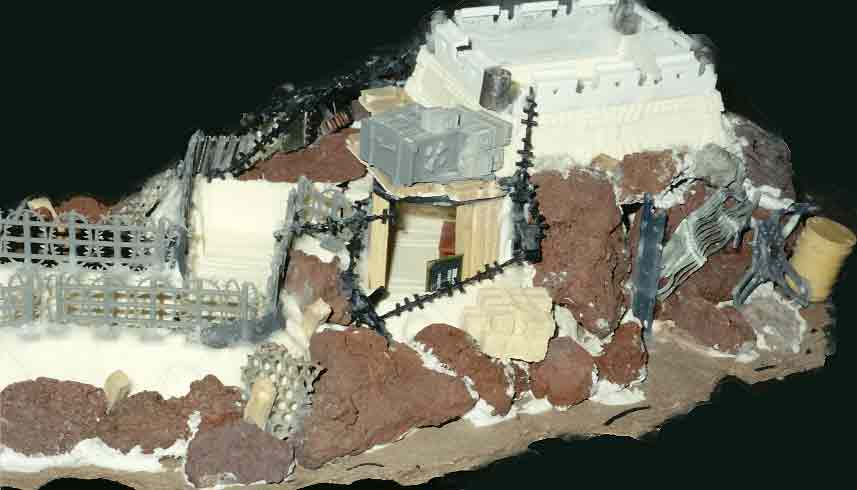
STEP 4- FILLING IN THE DIRT
Time for- you guessed it- more Concrete Patch! Grab a popsicle stick (or your finger) and scoop out a big blob. Use another popsicle stick (or your finger) to scrape it into the gaps between your rocks. You can tap it, scrape it, or mash it with your finger to get it to coat all the gaps. Don't be afraid to get some up on the edges of your debris, and go right up to the edge of your trench walls to make them look as deep as possible. Try dabbing at the concrete patch with a stick (or your finger) to form irregular shapes in the surface so it isn't glass smooth. You can even dab some into any exposed floor areas of your trench to represent mud or dirt! Leave as much of your rocks exposed as you like- you can have jutting crags or completely cover them over. Once dry, it's a good idea to rub your finger or a stiff brush over the concrete patch to brush off any loose chunks.
STEP 5- SURFACE DEBRIS
Like step 3, only now you're gluing items right to the top of the dirt. The concrete patch should be good and strong, so you can CA glue right to it. Try to glue pieces resting in a natural state- ammo crates and oil drums can't magically stick to the side of a steep slope; they'd more likely slide down until they caught on something! You can also glue plates of perf metal on, bent to fit over rocks, edges, etc. This is also the time to install barbed wire if you want. I like to use pieces of sprue for the posts. Drill some holes for your posts first, and CA glue them into the holes. Now for the quick and chunky method of making barbed wire... Get a pair of scissors and some of that cross stitch grid. Cut straight along a grid line, so that the cross lines leave behind little stubs or "barbs" sticking out along the edge. Now cut along the other edge of the line to get the same effect (it will look like a bunch of capital I's stacked on top of each other if you've done it right). Now glue one end to your first post with CA glue (baking soda helps form a good bond)- wrap it around the post once if you need to get a better bond. Now start twisting the strand lengthwise- the "barbs" should form a spiral pattern down the length. Keep twisting until the barbs look almost randomly distributed. Now wrap once around the next post, glue, and start twisting again, etc. until you have run out of line. You can double back or run double strands for extra nasty looking barbed wire.
STEP 6- PRIMING
Before you prime, it's a good idea to rub the whole piece down with a stiff brush or your hand. This will remove any loose concrete patch that didn't bond. You'll be surprised how little comes off! Now start spraying the piece- I recommend using flat black primer. Be sure to get a good coat on- check the piece from all directions, as most of your materials are light colored and will look bad if they aren't primed over. For a bit more color depth before you start painting, hit the piece with just a hint of rust red primer. Don't overdo the rust- you'll get plenty of color on there when you start painting! Yes, it's time to let the piece dry overnight again. Now for the paint- you can get results like this below very quickly with drybrushing...
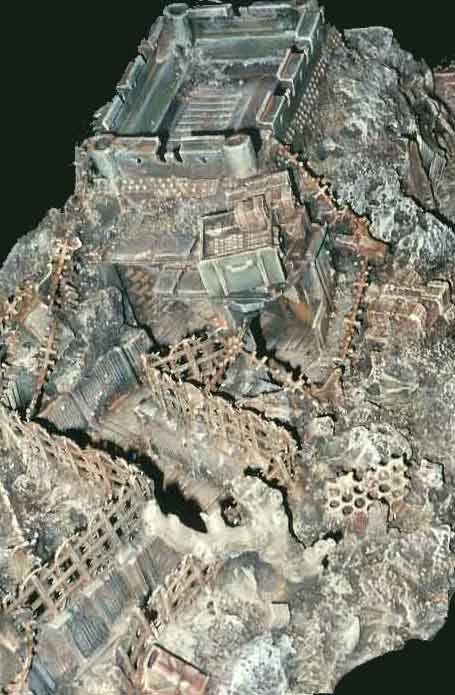
Dark Brown- drybrush over everything.
Rust- brush onto wood components (floorboards, crates, etc).
Grey- Drybrush onto exposed rocks
Tan- Drybrush over everything but metal, rocks
Olive green- drybrush over metal ammo crates and other military hardware
Rust- mix up a wash for all metal components
Steel, Brass- drybrush over barbed wire and other metal components
Light Brown- drybrush over select areas of dirt to add color depth
White- a final drybrush of white to catch highlights on rocks, dirt, wood, even metal
If some areas came out too light, I usually hit them with a dark brown wash, but otherwise you're done!
STEP 9 - WATER (optional)
At this point, you can add clear cast resin or layers of clear laquer to any craters, mud pools, etc. that you want to make "wet". This really adds depth to the piece! Make sure the areas to be filled are painted dark at the bottom, gradually lightening up to the sides. You can read more about clear cast resin on the Docks page...
No comments:
Post a Comment